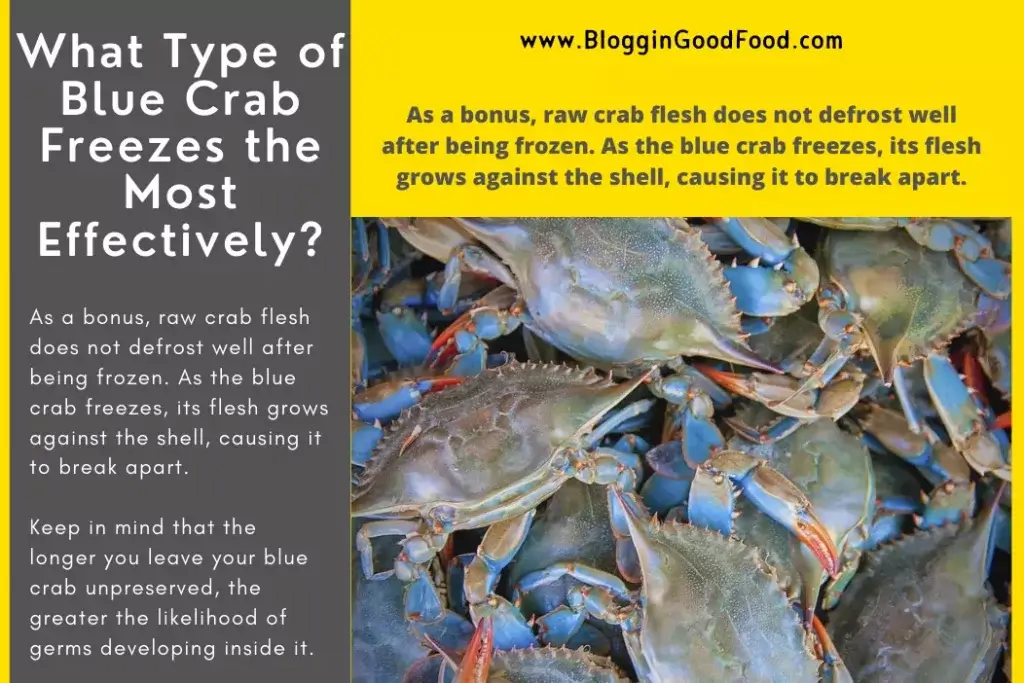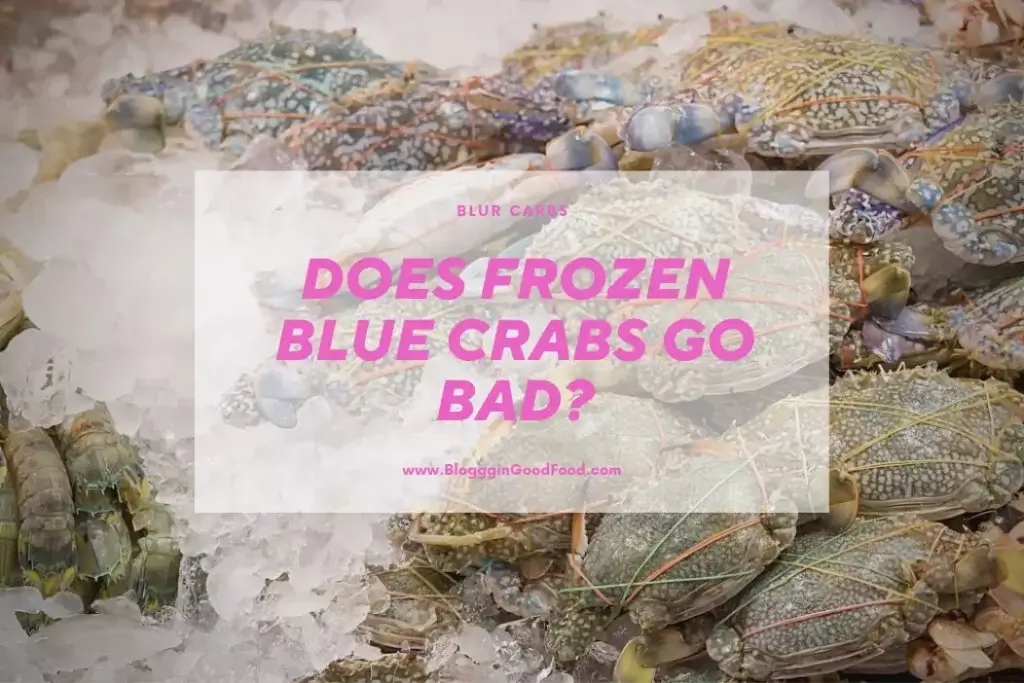In most parts of the world, blue crab is a popular seafood dish found in plenty. When it comes to preparing blue crab for supper, there are a variety of options available. One method is to freeze blue crabs before cooking them so that they are simpler to pull apart once they have been cooked. If you’ve never frozen your crabs before, here’s everything you need to know about freezing blue crabs properly!
Fresh seafood is popular throughout the summer months, but having live crabs on hand is not always possible due to practical considerations. This post will demonstrate how simple it is to preserve your catch by freezing blue crabs instead of catching them! You should read this post if this seems like something you’d be interested in trying out.
If you enjoy eating blue crabs but don’t want to pay for them every time you want some, this is the article for you. I’m going to show you how freezing blue crabs may help you save money while still allowing you to enjoy the delightful flavor of these delectable crustaceans all year long.
Table of Contents
Can You Freeze Blue Crabs?
Yes, you can freeze blue crab meat. Blue crab meat will remain safe to consume in the freezer for approximately three months after being frozen. Blue crabs that have been preserved for more than three months will be safe to consume, but their quality will have suffered.
Crabmeat has a delicious flavor and provides a variety of nutritional advantages. If you include crab flesh in your dishes, you will be providing your body with tremendous benefits.
The flesh is vitamin A, vitamin D, protein, and minerals such as calcium, phosphorus, zinc, and copper, among the many nutrients found in the blue crab. These minerals contribute to the development of healthy bones and teeth.
Blue crabs have a wide range of applications and may be used to enhance the sweetness of a wide variety of dishes. The blue crab is a seasonal meal that is only accessible for a short period each year.
How Do You Freeze Blue Crab?

The process of freezing your blue crab for long-term storage is easy and stress-free, but it will need some preparation. Preparing it will assist you in keeping them safe for consumption once they have been thawed. You may freeze the complete blue crab or only the crab flesh if you want to save space.
To freeze blue crab, you’ll need foil paper, cling wrappers, a glass of milk, a marker to label, freezer bags. To successfully freeze your blue crab, please follow the simple instructions listed below:
Step 1: Cooling the Blue Crabs
Let your blue crabs cool after they have been cooked before storing them in the freezer. By putting warm or hot food in the freezer, you might degrade its quality while raising the temperature of other food products.
Step 2: Blue Crab Portioning
Whole blue crabs may be frozen by wrapping them individually in a sheet of cling wrapper before placing them in the freezer. It is possible to reduce the likelihood of air entering the blue crab by covering it in foil paper a second time after the first.
Scrape the blue crab flesh from the shells and place it in a large mixing bowl before freezing. Pour milk over your crab flesh to keep it from becoming freezer burnt. After that, divide the crabmeat into serving-size portions and place them in separate freezer bags. This will make it much easier to defrost and prepare for eating.
Step 3: Storage
If a blue crab is left on the surface, the rate at which it spoils increases, resulting in a reduction in the quality of the crab. Whole blue crabs should be wrapped individually in cling wrap and then foil wrap to avoid air entering the crabs during storage.
Refrigerate or freeze your crab flesh in freezer bags. Keep a minimum of an inch of the upper portion of each freezer bag so that it is simple to close it. Before you close the freezer bag, press it firmly to release any trapped air that may have accumulated within.
Step 4: Time to Freeze
Mark each plastic container and freezer-safe bowl with the marker you’ve chosen. This will enable you to determine what is included in each bag, as well as the date on which it was frozen.
Ensure your blue crab is stored in a freezer section where it will not be contaminated by dirt. Also, be certain that your blue crab-filled freezer bags are not placed in a location where they might be punctured.
Afterward, using your marker, name each freezer bag and each mixing bowl. This will enable you to identify the contents of each bag as well as the date on which it was frozen. Let your blue crab be stored at a minimum of -15°F in the refrigerator freezer.
What Type of Blue Crab Freezes the Most Effectively?

Keep in mind that the longer you leave your blue crab unpreserved, the greater the likelihood of germs developing inside it.
The amount to which blue crab will resist the very cold temperature is dependent on how you treat and wrap it before freezing it in the first place.
We do not recommend that you freeze your blue crabs in their raw state. Raw or undercooked frozen blue crab poses a risk of food illness, and you should avoid eating it until it is fully cooked.
When a blue crab dies, the toxins quickly travel to other regions of the crab, rendering it unsuitable for freezing or food in the process.
As a bonus, raw crab flesh does not defrost well after being frozen. As the blue crab freezes, its flesh grows against the shell, causing it to break apart.
After thawing, the crabmeat shrinks and crumbles, making it unfit for consumption. Because you will have difficulty extracting the meat from the shell, you will have a tough time consuming this food item. Cooked blue crabs freeze the best since they don’t become stringy and lose their delicious flavor.
What Is the Best Way to Defrost Blue Crab?
In the case of pre-cooked whole frozen crab, all you have to do is thaw it in the refrigerator overnight.
In contrast, if you’re in a hurry and need to thaw the crab as soon as possible, wrap it in cling film and place it in a large bowl filled with cold water, or place it in your basin and run cold water from the tap over it. Make sure not to use boiling water because this can cause the crab to get mushy.
When defrosting crab legs, please place them in your refrigerator for around Twelve hours or more until they are thawed.
The crab legs will stay at an appropriate temperature for the duration of the defrosting procedure if this is done. Alternatively, you may defrost frozen crab legs by putting them in a strainer and pouring cold water over them for a few minutes before using them.
How Long Can You Freeze Blue Crabs?

Crab Meat that has been properly preserved will retain its optimum quality for around six months in the freezer, but it will typically still be safe to consume after that time.
Can You Store Uncooked Blue Crabs in the Freezer?
The temptation to place your newly captured crabs in the freezer until you are ready to prepare them might be strong after a hard day of crabbing. However, this is not the best option. This is a bad method of preserving your crabs.
It is never recommended to freeze live crabs. Live crabs that are kept at temps under 32° Fahrenheit will expire very fast. The presence of germs or unprocessed food within the crab’s internal organs will allow its meat to deteriorate, even in temperatures below freezing. All crabs should be boiled and washed before freezing to ensure their safety.
Can You Freeze Leftover Blue Crabs?
Yes! You should be able to freeze the crab flesh! 5 to 6 days It’s not an issue! If you plan to freeze leftover crab later for a longer time, I suggest vacuum-sealing the flesh, legs, or entire crab before putting them in the freezer.
Additionally, vacuum sealing will aid in the preservation of its freshness quality since, while some quality may be lost, it is unlikely that this will be significant enough to be noticed.
Does Frozen Blue Crabs Go Bad?

Crab legs may be kept frozen for up to 12 months and yet keep their delicious flavor. If you want to make sure you’re not eating crab legs that have gone bad, timestamp your seafood, so you remember when it was bought.
Blue crab flesh may be stored in the freezer for three months without losing its nutritional value. Blue crabs that have been preserved for more than three months will still be safe to consume, but their quality will have suffered.
How to Spot a Bad Blue Crab?

Germs can form on your blue crab if it is left unattended for an extended period after thawing. The blue crab that has been spoiled gets sticky, emits a foul stench, and changes color from blue to yellow.
To reap the nutritional advantages of blue crab, consume it immediately after being thawed and discard any spoiled.
What Part of the Blue Crab Should You Avoid Eating?
It is recommended that you avoid eating some portions of the blue crab since they are toxic to the human body. The blue crab’s lung is not recommended for human eating. It is a fluffy cone that emerges on the side of the blue crab’s body when it is young. Because it is difficult to digest in the stomach, it also has a foul flavor.
What Is the Best Way to Clean Blue Crabs?

If you enjoy cooking and want to prepare blue crabs on your own, I will show you how to clean blue crabs quickly and efficiently. Although most people prefer boiled whole, following these two simple procedures is preferable to plunging live crabs into a pot of boiling water.
- Make a crack in the top of the shell.
- Make certain that the intestines and gills are thoroughly cleaned.
What Is the Shelf Life of Cooked Crab in the Freezer?
When properly stored, it will retain its finest quality for around 2 to 3 months but will stay safe after an extended time. The freezer time indicated is solely for optimum quality; cooked crab meat maintained frozen at 0°F continuously will remain safe for a continuous period.
Frequently Asked Questions:
What is the maximum amount of time live crabs may be kept on ice?
For up to 48 hours, crabs will remain fresh in a cooler filled with ice, provided that they are kept out of standing water and that any melted ice is replaced after it melts.
Is it okay to eat frozen crab?
If you buy pre-cooked or fresh crab flesh, it is always advisable to get it frozen. The longer crab legs are allowed to defrost; the more taste is lost in the flesh.
How do you reheat blue crabs that have been frozen?
It is entirely up to you whether or not you reheat them. Remove the Blue Crabs from the freezer and place them in your steamer to warm them if they are in a hard shell condition and you want to fracture the legs at the table.
Is it okay to eat dead crab?
It is not recommended to prepare or consume a dead blue crab. When one crab expires, bacteria take advantage of the chance to spread throughout its body, rendering its flesh mushy and flavorless. Not only will it taste bad, but it also has the potential to make people sick. Eating dead crabs should be avoided at all costs.
Is it cruel to cook crabs when they are still alive?
Crabs have a difficult time surviving in the presence of people. They are exempt from the purview of animal welfare regulations in most nations, which means that nothing you do to them is prohibited. As a result, they are subjected to treatment that would be considered harsh if administered to a vertebrate.
Wrapping it Up:
The procedure for freezing blue crabs is easy, but it is essential to follow the instructions exactly. Following their freezing, these delectable treats may be kept in your freezer for up to a year at a time without suffering any significant changes in taste or texture.
All you need is some ice and cold water, and you won’t have to hire the services of an expensive seafood company or restaurant. Please double-check that you are following all of our directions to the letter before beginning this fun and rewarding exercise.
Putting in the extra work now will make life simpler later on when food storage becomes more difficult during the winter months when it will be even more difficult. Have a great day crabbing!







